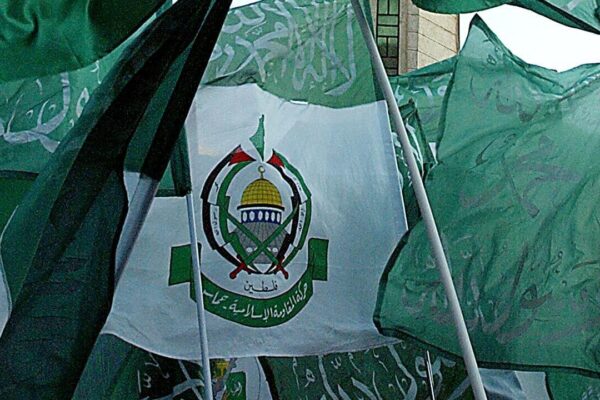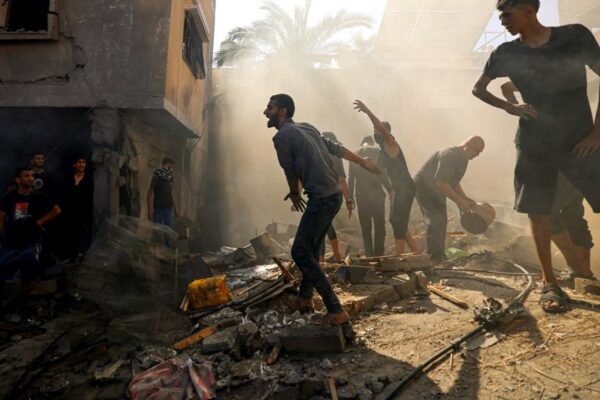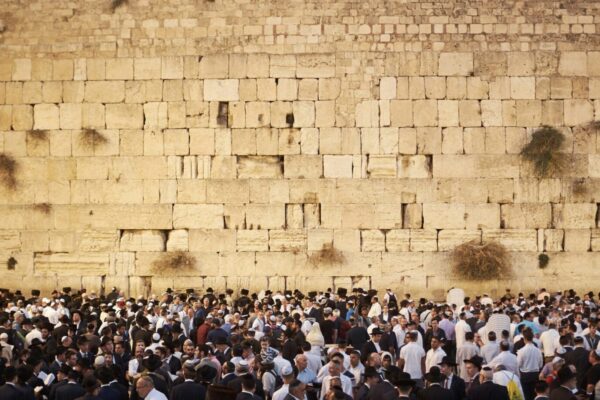At least 32 people, including two children, were killed and thousands more injured due to pager explosions that occurred.
At least 32 people, including two children, were killed and thousands more injured due to pager explosions that occurred.
![Ammar, H. (2023, October 22). [Funeral procession of Bilal Nmer Rmeiti]](https://themuslimvibe.com/wp-content/uploads/2024/09/Picture-1.jpg)
Photo credits: Credit: Hassan Ammar/AP Photo
Since the occurrence of the October 7th event, the war that has been unleashed between Israel and Gaza has been the focal point of conflict in the Middle East. The recent events of planted explosives in Hezbollah pagers going off across the country has predicted further their involvement in the war, as Hezbollah has pledged to seek vengeance against Israel, holding them “fully accountable”. So far reports have stated that 9 people have killed and approximately 2,750 people injured. It is therefore worth unpacking the relationship between Israel and Hezbollah and connecting it with the geopolitical history.
Hezbollah, translated as “Party of God” in Arabic, is a Shiite Muslim political party and militant group whose origins can be traced to South Lebanon. Its extensive security apparatus and external Iranian influence have allowed it to grow, being dubbed an almost “Mid-Sized Army.” The origins of Hezbollah have been opaque in contemporary media, hence it is worth dissecting their history in a deeper nature.
Hezbollah emerged during the turmoil of the Lebanese Civil War, with a primary objective of expelling Israeli forces following their invasion of southern Lebanon in 1982. Hezbollah’s history however is narrated by academics as a product of state activism to better Shiite interest within the region due to the community being heavily marginalised. Figures like Musa Al-Sadr established the Ḥarakat ʿAmal, (Hope Movement) which gained traction due to Sadr’s ideas calling upon peace and equality among all Lebanese confessions and religions.
However, despite its success in its formative period, inter-group disputes led many members to defect from its ranks. Many political analysts and authors state that the formation of Hezbollah was thanks to a massive influx of AMAL defectors into its ranks. The crux of its formation was also catalysed due to Iranian influence post-1979, where Iran sought to bridge the Arab-Persian gap based on a shared sense of religious identity.
Today Hezbollah’s military wing is designated as an FTO (Foreign terrorist organization by the US State Department, The United Kingdom, and several other countries, yet it holds 15 seats within the Parliament of Lebanon. Israeli forces officially withdrew from South Lebanon in 2000, however, they have always clashed with Israel since the dawn of its inception. To simplify the connections between other entities in the Middle East, it’s worth stating that Hezbollah, Hamas, and the broader “Axis of Resistance” are interconnected entities that play significant roles in the ongoing conflicts in the Middle East.
Political analysts have coined that the nexus of Hezbollah’s interaction with Iran and Hamas in the former comes from the wider objective to clamp down on Western influence and hegemony. Several academics and analysts have also stated that Hezbollah’s interaction with Iran and Hamas is part of a wider geo-political strategy to counteract Western influence, aligning with Iran’s broader ambition to assert itself as a dominating ruling power in the Middle East, to further its ideology of political Islam. Hezbollah’s early manifesto in 1985 constantly iterates this anti-imperialist tone, stating its goal was to expel Western powers and their influence from Lebanon and the wider Middle East.
However, the shift in its religious underpinnings enabled the militant group to adopt a more nationalist character throughout the 1990s and 2000s, often compromising it with its religious agenda, yet, over the recent years, it has marketed itself to take the tone that tries to encompass all Lebanese society rather than focusing on its sectarian goals.
October 7th and Hezbollah’s involvement
Now that we have stated the backdrop surrounding Hezbollah’s involvement in the Israeli-Gaza war, the rationale behind Hezbollah’s involvement unravels itself to becomes a lot clearer. Hezbollah immediately got involved and started firing toward Israel on October 8th. According to the Armed Conflict Location and Event Data Project, Hezbollah, and other armed Lebanese resistance groups have exchanged at least 4,733 attacks across the border from October 7, 2023, to March 15, 2024. According to Al Jazeera, Israel conducted about 83% of these attacks. Since the war, Israel has attacked notable locations in southern Lebanon such as Aita al-Shaab and Ras al-Naqoura at least over two hundred times combined, Hezbollah retaliated by attacking locations in northern Israel such as Kiryat Shmona and the Shebaa Farms.
Hassan Nasrallah in his speeches since October has stated that his group will not stop its cross-border attacks on Israel unless a ceasefire is granted. Amal Saad, the author of two books on Hezbollah has also gone on to solidify that view, stating that the war will be ongoing until a permanent ceasefire prevails between Hamas and Israel. Hezbollah’s firepower and numbers also remain strong, A statement from the senior U.S. official at the Middle East America Dialogue (MEAD) has warned that the cost remains heavy if military action alone is enough to stop Hezbollah entirely, stating that a full-scale war between Israel and Hezbollah would have death tolls rising by the thousands. The strength and military capacity of the group remains very strong. Hezbollah’s leader, Hassan Nasrallah, had boasted that the group has 100,000 fighters with many more wishing to volunteer and join the ranks since the incidents that have occurred on October 7th.
The recent events of Hezbollah pagers being compromised have led to a vow of vengeance iterated by the group. Reuters have reported that the UN special coordinator for Lebanon Jeanine Hennis-Plasschaert has stated that the attack has been marked as an extremely concerning event in the escalation of the conflict. Many broadcast outlets have speculated that Mossad was involved in the operation, with The New York Times stating Israel hid explosive material in the Taiwan-made Gold Apollo pagers. What happens next remains ambiguous yet this incident makes no effort to reduce tensions between the two entities. A ceasefire deal remains opaque with almost a year of war being marked in the coming weeks.
References
Al Jazeera. (2023, October 8). Israel, Hezbollah exchange fire, raising regional tensions. Al Jazeera. Retrieved September 19, 2024, from https://www.aljazeera.com/news/2023/10/8/israel-hezbollah-exchange-fire-raising-regional-tensions
Al Jazeera. (2024, April 15). Mapping Israel-Lebanon cross-border attacks. Al Jazeera. Retrieved September 19, 2024, from https://www.aljazeera.com/news/longform/2024/4/15/mapping-israel-lebanon-cross-border-attacks
Al Jazeera. (2024, June 26). Hezbollah’s axis of resistance: Allies waiting in reserve to fight Israel. Al Jazeera. Retrieved September 19, 2024, from https://www.aljazeera.com/news/2024/6/26/hezbollahs-axis-of-resistance-allies-waiting-in-reserve-to-fight-israel
BBC News. (n.d.). Live updates: [Title of specific article if available]. BBC News. Retrieved September 19, 2024, from https://www.bbc.co.uk/news/live/cwyl9048gx8t
Central Intelligence Agency. (2009, May). [Title of document if available] (Document No. DOC_0000361273). Retrieved September 19, 2024, from https://www.cia.gov/readingroom/docs/DOC_0000361273.pdf
Center for Strategic and International Studies (CSIS). (2024, September 19). Examining extremism: Hezbollah. CSIS. Retrieved September 19, 2024, from https://www.csis.org/blogs/examining-extremism/examining-extremism-hezbollah
Council on Foreign Relations (CFR). (2024, June 26). What is Hezbollah? Council on Foreign Relations. Retrieved September 19, 2024, from https://www.cfr.org/backgrounder/what-hezbollah
Encyclopaedia Britannica. (n.d.). Hezbollah. In Encyclopaedia Britannica. Retrieved September 19, 2024, from https://www.britannica.com/topic/Hezbollah
Haaretz. (2016, July). [Title of article if available]. Haaretz. Retrieved September 19, 2024, from https://web.archive.org/web/20220408153940/http:/www.haaretz.com/st/c/prod/eng/2016/07/lebanon2/
Reuters. (2024, September 17). Dozens of Hezbollah members wounded in Lebanon when pagers exploded – Sources, witnesses. Reuters. Retrieved September 19, 2024, from https://www.reuters.com/world/middle-east/dozens-hezbollah-members-wounded-lebanon-when-pagers-exploded-sources-witnesses-2024-09-17/
Times of Israel. (2024, [Date of article]). Top US official warns of catastrophic consequences to war in Lebanon – reports. Times of Israel. Retrieved September 19, 2024, from https://www.timesofisrael.com/top-us-official-warns-of-catastrophic-consequences-to-war-in-lebanon-reports/
Oxford Academic. Author(s). (Year). Title of chapter. In Title of book (pp. pages). Publisher. Retrieved September 19, 2024, from https://academic.oup.com/book/32400/chapter-abstract/268692226?redirectedFrom=fulltext&login=false





